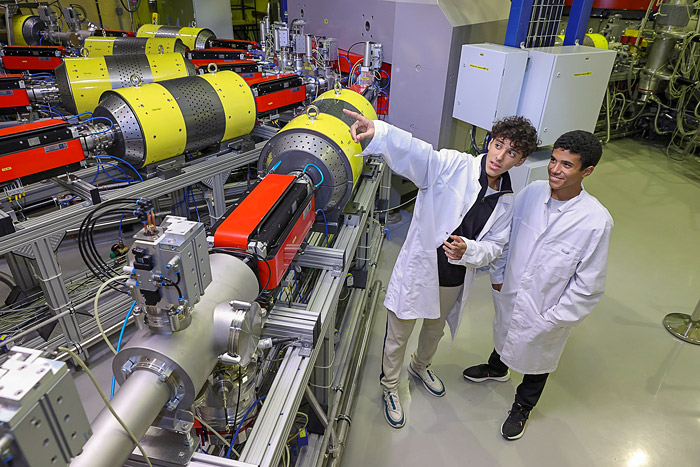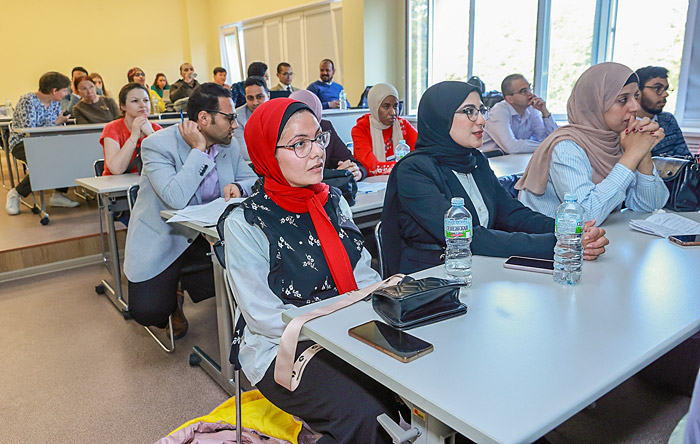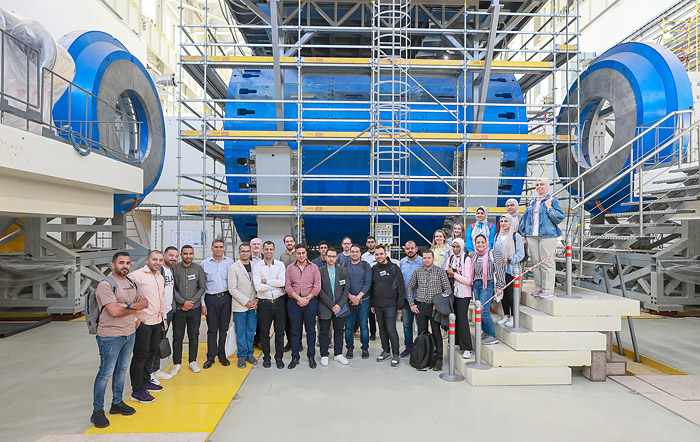
Electronic english version since 2022 |
The newspaper was founded in November 1957
| |
Meridians of cooperation
Egypt - JINR: science, culture, education
Cooperation between JINR and the Arab Republic of Egypt started in the 1960s of the last century. Work on projects, mutual visits and exchange of knowledge over many years has resulted in a logical result: two years ago, Egypt became an official Member State of the Joint Institute. In October, the JINR delegation headed by Vice-Director Lachezar Kostov visited Egypt, where a number of meetings were held in scientific organizations of the country, as well as a meeting of the Joint Coordination Committee for Cooperation, at which the results were summed up and joint projects and plans were discussed. The correspondent of the weekly asked Wael Badawi, a senior researcher at the FLNP, to comment on this event, as well as to talk in more detail about current work and prospects that invited participants of scientific research in which the Egyptian state is interested in to the meeting.
Archaeological projects
Studying the past, we sometimes make amazing discoveries that can change our ideas about the development of science and technology. Monuments of ancient Egyptian art are, of course, an invaluable source of information about the achievements of the Egyptians in the fields of painting, architecture and engineering. This topic turned out to be central in a conversation with Head of the Group of Neutron Activation Analysis at FLNP A.Yu.Dmitriev.
"Andrey Yurevich, tell us, please, about joint projects with Egyptian scientists."
"We widely develop cooperation with Egypt. First of all, thanks to Wael Badawi that provides contacts between scientists. We currently have three joint projects. The topics of two are related to environmental investigations of samples that were collected in Egypt."
"What results of cooperation do you consider the most significant?"
"For us, as researchers, the main result of our activities is publications in the world's leading journals. For example, just the other day, we received news that our article was published in Marine Pollution Bulletin (a scientific journal with a high impact factor about research in the fields of ichthyology, oceanography, and pollution)."
"Tell us about your immediate plans, please."
"We hope to gain access to the investigation of samples of Egyptian cultural heritage. Egypt is a country with an extremely rich history, our school history books start with Ancient Egypt, everyone knows, for example, who the pharaohs are and what a mummy is, so getting access to the research of such specimens is a very interesting task with promising and I hope, important results. However, no less important and interesting is the process of studying artifacts that belong to the era of early Egyptian Christianity, the so-called "Coptic period" (an unofficial designation for Late Roman Egypt of the 3rd-4th centuries and Byzantine Egypt of the 4th-7th centuries). Copts are Egyptian Christians, descendants of the population of Ancient Egypt that have preserved unique monuments of the religious culture of early Eastern Christianity. In December, our delegation will travel to Egypt to meet with the leadership of the monastery of St. Macarius of Egypt and discuss the prospects for studying monumental painting of the fourth century. We have quite serious experience in studying ancient Russian painting. We are talking about Veliky Novgorod and Pskov. This is pre-Mongol painting, with rare surviving examples. In the field of research of monumental painting, we cooperate with the State Institute of Art Studies, the Institute of Archeology, the museums of the Moscow Kremlin, Staraya Ladoga and the Interregional Scientific and Restoration Art Directorate. We have already completed several projects, including for restorers.
"How can physicists help restorers?"
"In our country, the technique of scientific restoration is currently practiced: before starting to work with any monument, it is necessary to implement physical and chemical investigations.
Let me give you an example: before you wash off any layer with solvents, you need to know what substance you will be working with. You can choose the wrong material and instead of restoring it, cause even more damage. All projects that are officially submitted to the Ministry of Culture are accompanied by the results of physical and chemical research and we take part in such research. Since we have a wealth of experience, we are ready to offer it for the research of historical monuments in Egypt."
"What are the difficulties in starting such projects?"
"If the research of environmental samples is an already established process, then gaining access to samples of cultural heritage is not an easy task. In Egypt, they are very strict about historical artifacts; numerous permits are required. We have already done a lot in this area."
W.Badawi adds: "As for the difficulties... If the samples are recognized as historical value, then it is difficult to remove them from the museum, so permission to work with archaeological artifacts has to be obtained in advance. Since we have a joint project, we will travel to Egypt to present the results of this work to different audiences and attract the attention of new partners. I would also like to remind you that in April next year, the annual event of the Frank Laboratory of Neutron Physics ISINN-30, the International Seminar on the Interaction of Neutrons with Nuclei will be held in Egypt. It is necessary to attract not only great scientists, but also students, young talented researchers that would like to have access to this science. We are going to interest a large audience, to establish contacts and scientific cooperation."
Environmental projects
Egypt is the largest state in Africa and the Middle East; the Nile, the longest river in the world, flows through its territory, so environmental research is of particular importance here. Two projects were recently carried out by joint efforts of scientists from JINR and Egypt. The first examined the environmental situation, using neutron activation analysis and related analytical methods to carry out a comprehensive analysis of the study area. The second project is dedicated to the research of rocks in mines in Egypt. W. Badawi that studied surface sediments and soils on the banks of the Nile, studied the Red and Mediterranean Seas, mineral resources in the southeast of Egypt, spoke about these projects.
"How do you use neutron activation analysis to biomonitor the air in Egypt using mosses, if they are not there?"
"Unfortunately, we have not got any mosses; in Egypt the climate is hot and dry. I'll tell you a funny story. We first wanted to estimate the environmental situation in the air - to study emissions in Greater Cairo and then to compare the data obtained with other cities. We wanted to use moss for research and collected it here, in Dubna on the left bank. One of our master's students took 60 packages with her and hung them in different places in Cairo. We were going to take three packages for investigation every three months and thus to carry out extensive monitoring throughout the year. And when three months later, we went for samples, we found nothing! The bags turned out to be empty, because due to the heat and dryness, the moss dried out and scattered. Therefore, we had to use higher plants - ficus and eucalyptus that are very common there. We took samples of these plants, soil samples and began to study the correlation between them. When the influence of soil is taken into account, all that remains is the influence of air composition, including heavy metals from exhaust gases. Surprisingly, we determined that Cairo is not as polluted as we thought, compared to other regions where waste controls have been relaxed. While processing the data, we could even determine where the sample was taken from: from trees growing along highways or inside the city.
"Will you carry out such research in future?"
"Yes, we are going to study the territory in the Nile Delta in a similar way.
If our projects find support, we will study the environmental situation using soil samples and satellite photography. Also, in Egypt there are more than two dozen fairly large freshwater lakes, we need to study them for the content of chemical elements."

Wael Badawi and Galina Myalkovskaya
Geological projects
Since ancient times, the Eastern Desert of Egypt has been known for gold deposits. More than 90 gold mines have been discovered here, the largest of which are located in the central and southern regions. Employees of Mansoura University selected rock samples from these territories and sent them to JINR to determine the elemental composition. The results showed that these areas are of interest to the mining industry, including from the point of view of gold mining. Such investigations are also carried out in other areas of the Eastern Desert; they will help to more accurately determine promising areas for development and save time on geological exploration.
Professor Said Salim from the National Agency for Remote Sensing and Space Sciences spoke at the meeting about a promising research with a similar topic: "In this case, we can study the surface and internal composition of soils not only using neutron activation analysis of samples, but also using satellite photographs. We will find the relationship between the data of the NAA and satellite sensing of the surface. In the future, it will be possible to apply advanced technologies to these results: machine learning, artificial intelligence, simulation and thus make predictions. This is a joint research of the environmental situation and the search for minerals."
"At what stage is the project?"
"We have already drawn up a description, agreed upon it in groups, received approval from Egypt and recommended it for implementation next year," answers W. Badawi.
"Are a lot of minerals mined in Egypt?"
"Yes, a lot of work is underway to search for gold, lead and nickel. The mineral composition of the soil is, in principle, rich, especially in the southeastern part of the country, near the Red Sea. The pharaohs knew where to dig," Wael laughs.
Educational project
Another of our interlocutors is a young man from Tunisia, Ibrahim Khalifa, Director of the JINR Information Centre, located at the headquarters of the Arab Atomic Energy Agency (AAEA), the technical opening of which was held on 19 May. He came for an internship at the Educational and Scientific Centre. In the group of Yury Anatolievich Panebrattsev, he learns about how to talk about the Institute using digital media technologies.

"I came here for a week to learn about the basic facilities and the JINR infrastructure, since the duties of Director of the Information Centre also include disseminating information about JINR among the Agency's Member States. I have already visited the laboratories to get a comprehensive understanding of the Institute's activities. This week, I have worked with the virtual laboratory. Today (November 24 - Ed.) is my last day in Dubna. I learnt about the activities of JINR, the work of the Group of Neutron Activation Analysis and went to the exhibition of basic facilities at the Cultural Centre "Mir". In Tunisia, I work in a virtual laboratory that gives tasks to students in nuclear physics: the interaction of radiation with matter, spectrometry and others. And I am ready to tell our public about this project."
Before the visit of the JINR delegation headed by JINR Director Grigory Trubnikov to Tunisia, Ibrahim Khalifa had to organize the work of the Information Centre as a portal to JINR for the 14 Arab AAEA member States, act as a JINR Ambassador, talk about what he saw in Dubna, about plans to disseminate information about JINR that will help to attract young scientists and students to carry out master's or candidate's papers at JINR.

W.Badawi noted: "We have proposed for Egypt and will propose for the Agency to create models of the JINR basic facilities. It gives a more visual representation, for you can press buttons and see what happens, for example, in the accelerator. Within the framework of the cooperation between JINR and AAEA, the competitive JINR for AAEA Fellowship Programme was launched. The first six winners of the competition will soon come to Dubna to carry out scientific tasks for 1-2 years. These are representatives of Jordan, Egypt and Yemen."
Youth projects
Egyptian scientists, students and even schoolchildren visit the Institute more and more often.

"We have several formats for it," W.Badawi says. "These are joint projects, international student and school practices. If we talk about the total number, we had 10 ongoing projects, and it seems to me, a leader from Egypt came to each project. About 25 people came to the international student practice and then another 14 schoolchildren with their leaders. That is, a fairly large number of scientists and students are sent from Egypt to take part in JINR activities. At the meeting of the Joint Coordination Committee for Cooperation with the Arab Republic of Egypt, headed by the Plenipotentiary Representative of the Government of Egypt at JINR Professor Mahmoud Sakr and Vice-Director of JINR Lachezar Kostov, we also decided to send employees to JINR for a long term. Next year, we expect the arrival of a large number of Egyptian scientists to participate in research in different fields of science and in different JINR laboratories."
"What basis are school practices organized on?"
"This is the second year we have been bringing our schoolchildren to Dubna. This event is called the Scientific School for Students of the Children's University at the Egyptian Academy of Scientific Research and Technology. There are many scientists working at the children's university that strive to instill in children an interest and love of science. An announcement about the upcoming practice is posted on the website of the Academy of Sciences. Parents or children send documents and applications for participation. They are trained at various universities in the faculties of natural sciences, teachers teach them and then they take exams. After this, students undergo an interview. This year, more than 250 people registered in the first stage, 70 were admitted to the second. That is, there are a large number of people wishing to visit JINR and the interest is great."
"Why are such practices popular among Egyptian youth?"
"At least, they help to mark the road and guide the choice of a future profession if a student shows talent for studying physics. As part of the programme, we arranged a meeting with students of the V.G.Kadyshevsky Lyceum. And both parties enjoyed the communication. The participants quickly found a common language, exchanged phone numbers, social media accounts and today keep in touch. Such practices are an encouragement for a child that has studied well, passed exams and passed an interview. We send them to a science centre for a week to see what it all really looks like.
"During the visit of the JINR delegation to Egypt, you visited the City of Science, Technology and Innovation Zewail City. Tell us a little about it, please."
"Ahmed Hassan Zewail is a famous Egyptian chemist, winner of the Nobel Prize in Chemistry in 1999. He initiated the Zewail City social project that promotes the development of science in Egypt. We have three categories of universities: public, private and national. Zewail City is a private university, but also receives government support. They teach many specialties there and of course, there is a great demand for university graduates, because many talented, highly qualified students study there. There is a department of theoretical physics and a wide range of other sciences."
Galina MYALKOVSKAYA,
photo by Igor LAPENKO
For reference:
On 20 December, 2012, a special law was passed for the city of Zewail, allowing students to enter its university and Egypt to begin a new era of modern development in scientific research and technological production.
In 2014, a presidential decree was issued granting Zewail a new campus on 200 acres in a satellite city of Cairo.
Zewail City of Science, Technology and Innovation strives to have a transformative impact on society by raising education standards to world-class levels and constantly innovating in research to lead scientific development in Egypt.
